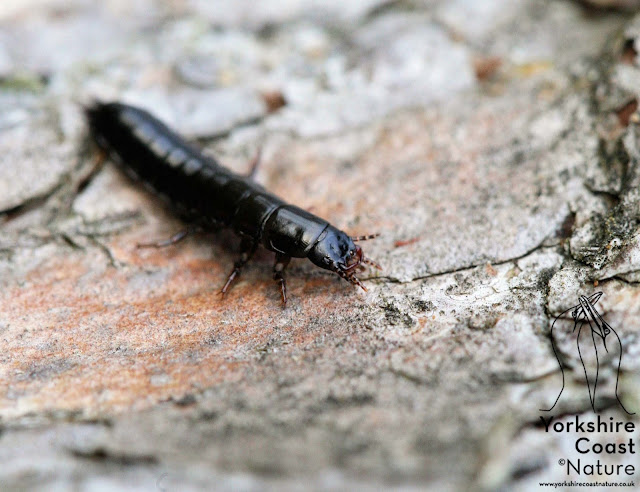Pterostichus
melanarius a key predator and important prey species across the region.
With another weekend of the YETI challenge gone, we finally
managed to add a couple of ground beetles, or carabids as they are
scientifically known, to the list. This group of insects really are the dark knights of the micro-world. They are fast and powerful nocturnal predators, with
large eyes and lethal jaws, perfectly evolved for slicing through flesh. The
first of these species found (shown below) is Cychrus caraboides also known as the snail killer. Much like a Frenchman
in a restaurant and as its name suggests is rather fond of Escargot. Unlike a
Frenchman it has evolved a slender head for accessing the juicy snail from
within its shell. As was mentioned in an earlier blog post the wet summer has
caused mollusc numbers to explode, this is surely to the advantage of these
beetles. The beetles themselves are top of the menu and you only have to look
at corvid, little owl and common gull pellets or hedgehog and fox droppings to
see how much they are liked. To these species finding a ground beetle is like
walking into a Michelin Star Restaurant. Subsequently they are not only an
important predator but also an important prey item within ecosystems across the
region.
Natures answer to a
slug pellet Cychrus caraboides, in a hibernation cell which it has created in a
rotten log.
Meet Junior, every bit as
much of a predator as an adult. This individuals was found
climbing a larch tree systematically looking for prey.
What knight would be complete without a shield? well fortunately we managed to find two this weekend. The first of which is the Forest Bug Pentatoma rufipes, which overwinters as a young (1st instar) nymph. Typically associated with oaks, alders and hazel, this was one of many found on alder. Interestingly for a shieldbug they grow up to be partially predatory. The second species was a Hawthorn shieldbug Acanthosoma haemorrhoidale in the form of a final instar (the one before adult) nymph on a sycamore. Despite the name they are found on a wide variety of species, but have a preference for feeding on hawthorn berries.
Forest bug, overwinter
as young nymphs, before growing into a predator not content with feeding on
leaves and fruit.
Hawthorn Shieldbug,
usually overwinter as adults, but not in the case of this nymph.
Continuing the knight theme we almost managed to find a
horse, well almost. We found a hoof fungus Fomes
fomentarius AKA Tinder Fungus. This curious species is predominantly found on
birch, initially as a parasite when damage and broken bark occurs then when the
tree dies as a decomposer.
Hoof fungus, a species
found growing amongst birch woodland and like birch polypore often associated
with great spotted woodpecker nest sites.
With cold weather
predicted next week will we see even more Ducks come into the region? How many species can you spot?







No comments:
Post a Comment